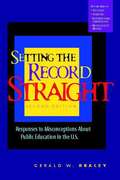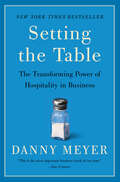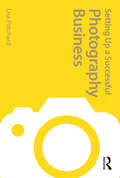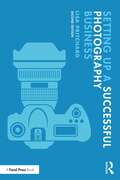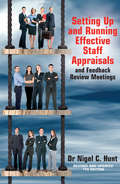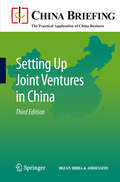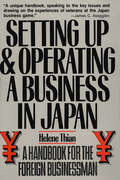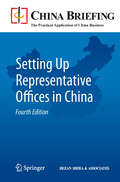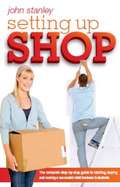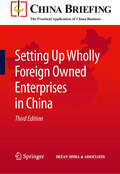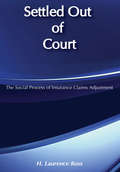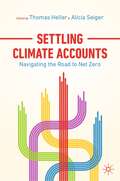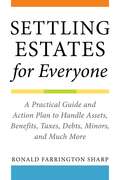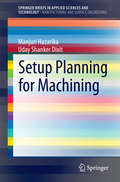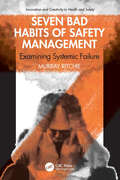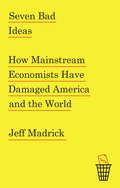- Table View
- List View
Setting the Record Straight: Responses to Misconceptions About Public Education in the U.S.
by Gerald W. BraceyIn this second and substantially updated edition of the hard-hitting Setting the Record Straight, Bracey, whom Washington Post education reporter Jay Mathews called "one of this country's most authoritative defenders of the work of public school teachers," goes toe-to-toe with the opponents of quality public education. You'll learn how to discredit them in your own discussions by using the very logic and statistical analyses they purport to have on their side.
Setting the Stage: The Expectations of New Managers and Those Around Them and Defining the Managerial Role
by Linda A. HillThe promotion to manager is a pivotal juncture in your career. The transition from individual contributor to manager, however, is difficult. Author Linda A. Hill followed nineteen new managers through their first year, gathering data about the managerial transition. Her interviews revealed that the expectations of new managers almost always conflict with the expectations of those around them, giving rise to unexpected challenges that can throw even the most eager and motivated recruits for a loop. This chapter examines the conflicting expectations of new managers, their subordinates, their superiors, and their peers, demonstrating the difficulty of defining the managerial role in the first place and learning how to become a manager given the demands of various constituencies. This chapter was originally published as Chapter 1 of "Becoming a Manager: How New Managers Master the Challenges of Leadership."
Setting the Table: The Transforming Power of Hospitality in Business
by Danny MeyerIn October 1985, at age twenty-seven, Danny Meyer, with a good idea and scant experience, opened what would become one of New York City's most revered restaurants--Union Square Cafe. Little more than twenty years later, Danny is the CEO of one of the world's most dynamic restaurant organizations, which includes eleven unique dining establishments, each at the top of its game. How has he done it? How has he consistently beaten the odds and set the competitive bar in one of the toughest trades around?In this landmark book, Danny shares the lessons he's learned while developing the winning recipe for doing the business he calls "enlightened hospitality." This innovative philosophy emphasizes putting the power of hospitality to work in a new and counterintuitive way: The first and most important application of hospitality is to the people who work for you, and then, in descending order of priority, to the guests, the community, the suppliers, and the investors. This way of prioritizing stands the more traditional business models on their heads, but Danny considers it the foundation of every success that he and his restaurants have achieved. Some of Danny's other insights:Hospitality is present when something happens for you. It is absent when something happens to you. These two simple concepts--for and to--express it all.Context, context, context, trumps the outdated location, location, location.Shared ownership develops when guests talk about a restaurant as if it's theirs. That sense of affiliation builds trust and invariably leads to repeat business.Err on the side of generosity: You get more by first giving more.Wherever your center lies, know it, name it, believe in it. When you cede your core values to someone else, it's time to quit.Full of behind-the-scenes history on the creation of Danny's most famous restaurants and the anecdotes, advice, and lessons he has accumulated on his long and ecstatic journey to the top of the American restaurant scene, Setting the Table is a treasure trove of innovative insights that are applicable to any business or organization.
Setting the Virtuous Flywheel in Motion: Understanding the Critical Role of Great Leaders in Realizing the Potential of Their People
by Justin MenkesYour identity as an executive-level leader is dependent on the environment you create within your organization: you can't separate out your success or failure from the people you lead or the culture you've engendered. In this chapter, Justin Menkes, a noted expert in executive assessment, profiles a maestro CEO--Dave Dillon, head of supermarket giant Kroger--showing how Dillon's organization exemplifies the ongoing interactive system great leaders cocreate with their people. In his leadership, Dillon demonstrates the three attributes necessary to a great leader and how they have transformed both his organization and Dillon himself: realizing potential, subservience to purpose, and finding order in chaos. These are the attributes you need to succeed as a great leader in the high-pressure global economy of the twenty-first century. This chapter was originally published as Chapter 8 of "Better Under Pressure: How Great Leaders Bring Out the Best in Themselves and Others."
Setting up a Sovereign Wealth Fund: Some Policy and Operational Considerations
by Udaibir S. Das Yinqiu Lu Christian Mulder Amadou SyA report from the International Monetary Fund.
Setting up a Successful Photography Business: How To Be A Professional Photographer
by Lisa PritchardSetting up a Successful Photography Business is a practical and essential handbook for anyone who wants to be a professional photographer. Written by the owner of a successful photography agency, it is packed full of helpful information and invaluable advice from not only the author but also many leading photographers and commissioners working in all areas of the industry today. This book includes all the essentials- how to prepare the best portfolio and website; how to market yourself and get clients; how to cost and produce shoots; how to find representation; how to finance and run your business; how to deal with contracts and legal obligations plus much more. It also contains lots of useful checklists, charts and handy business templates- everything you need to know to get your own photography business off to flying start.
Setting Up a Successful Photography Business
by Lisa PritchardThis revised second edition of the best-selling handbook provides practical, actionable insights on how to establish a successful photography business in the current climate. Written from the perspective of a photographer's agent, this book offers the perfect viewpoint to honestly assess what works, what doesn't, and why some photographers succeed where others fail. Packed with useful templates and advice from leading photographers and commissioners working in all areas of the profession today, industry expert Lisa Pritchard covers all of the essentials: preparing the best portfolio and website; marketing yourself; getting clients; costing and producing shoots; finding representation; financing and running your business; navigating contracts and legal obligations; and more. Updated to take account of shifts in the industry and the increasing importance of digital marketing and social media, this book provides fresh insight and inspiration for the budding and established professional. This book is essential reading for anyone who wants to be a professional photographer – whether studying to become one, thinking of a change of career, or wanting to know how to improve their existing photography business.
Setting Up and Running Effective Staff Appraisals, 7th Edition: and Feedback Review Meetings
by Dr. Nigel HuntRegular staff reviews will help an organisation to be effective and efficient (and hence more profitable), and will help the individual employee gain more job satisfaction. A satisfied employee is going to work better; a more profitable company means a happier boss. It's that simple. This book is a thorough, comprehensive guide for anyone involved in staff reviews. It covers: *Conducting appraisals in an open organisation with a narrative focus *Appraisal skills - interview techniques and listening and counselling skills *Eight rules for successful negotiation *The role of job analysis, job description and person specification *Different types of appraisal *Preparing for the appraisal * Conducting the interview and evaluating the appraisal *What can go wrong and what to watch out for *Resolving conflict. Thoroughly revised and updated edition.
Setting Up Joint Ventures in China
by Andy Scott Sam Woollard Chris Devonshire-EllisThis brand new guide book is a comprehensive overview of establishing joint ventures in China. It details all applicable decision making processes such as assessing your potential partner, choosing the relevant JV structure, conducting legal and financial due diligence. The guide contains complete JV contract and articles of association as well as an overview of JV law, details negotiation issues, land use rights, IP Protection and technology transfer, in addition to tips on staff hiring and HR. It also describes the tax and audit responsibilities in addition to buying out a JV partner and liquidations. It is a concise, detailed yet pragmatic guide of use to anyone considering or owning a JV in China.
Setting Up & Operating a Business in Japan
by Helene Thian"A unique handbook, speaking to the key issues and drawing on the experiences of veterans at the Japan business game." --James C. Abegglen, Cofounder, Boston Consulting GroupMore and more foreign-owned businesses are set up in Japan every year-and dozens fail because they are not set up properly. Now, an American lawyer working in Tokyo has written this new, compact handbook that will give you all the information you need to get your business off the ground and keep it there. Packed with business tips, legal information, interviews with successful foreign business people, and insider perspectives on Japanese business practices, this book is essential for the entrepreneur, the foreign enterprise representative, or anyone who wants to build a successful business in the world's most competitive marketplace.Topics of Setting up and Operating a Business in Japan include: Working with the Japanese. Forming a Company. Financing. Taxation. Visas. Employees. Cost of Doing Business. Advertising. Pros and Cons of Being a Foreign Business. Business Advice. Business Organizations. Professional Clubs. Helpful Organizations. Communication Services
Setting Up & Operating a Business in Japan
by Helene Thian"A unique handbook, speaking to the key issues and drawing on the experiences of veterans at the Japan business game." --James C. Abegglen, Cofounder, Boston Consulting GroupMore and more foreign-owned businesses are set up in Japan every year-and dozens fail because they are not set up properly. Now, an American lawyer working in Tokyo has written this new, compact handbook that will give you all the information you need to get your business off the ground and keep it there. Packed with business tips, legal information, interviews with successful foreign business people, and insider perspectives on Japanese business practices, this book is essential for the entrepreneur, the foreign enterprise representative, or anyone who wants to build a successful business in the world's most competitive marketplace.Topics of Setting up and Operating a Business in Japan include: Working with the Japanese. Forming a Company. Financing. Taxation. Visas. Employees. Cost of Doing Business. Advertising. Pros and Cons of Being a Foreign Business. Business Advice. Business Organizations. Professional Clubs. Helpful Organizations. Communication Services
Setting Up Representative Offices in China
by Andy Scott Sam Woollard Chris Devonshire-EllisDo you want to do business in China? If you are already in this vast country and want to know more, or if you have never tried your hand at this fascinating market, then this book is for you. This Guide is a practical overview for the international businessman to understand the rules, regulations and management issues regarding establishing Representative Offices in China. We will help you to understand the implications of what can initially appear be a complicated and contradictory subject. This book tells you the basics of what you need to know, and point you at the structures you should use as well as some of the pitfalls. This book is the first in a new series of books on doing business in China, which will progressively cover such topics as setting up wholly foreign-owned enterprises, setting up joint ventures, tax, IP and many other vital issues for foreign investors in this exciting market.
Setting Up Shop
by John StanleyRetailing is one of the most exciting professions you can enter. In Australia, this dynamic and growing industry is worth over $18 billion a year. Many new enterprises fail because they do not do their homework when they start their business. Setting Up Shop is a toolkit for anyone starting or buying a retail business in Australia, and aims to provide a simple step-by-step approach to setting up a retail business. It covers everything from buying an existing business versus starting a business, writing a business plan, location and buying versus leasing, to finance, pricing, merchandising, recruiting, marketing and succession planning.
Setting Up Treasuries in the Baltics, Russia, and Other Countries of the Former Soviet Union
by Barry H. Potter Jack DiamondThis summary presents the results of an internal self-evaluation of the technical assistance provided by the IMF to help develop treasuries in the Baltics, Russia, and other countries of the former Soviet Union. 1 The findings from the assessment are intended principally for those interested in the development of these transition economies, but should also be of wider relevance to those involved in delivering technical assistance on public sector institutional reform. The assessment follows the standard approach to such evaluation work. It first considers whether the basic goal of setting up treasuries has been achieved and whether the resultant reforms are relevant and sustainable. Then, it reviews the costs of the inputs, the outputs, the efficiency with which the technical assistance was delivered, and the effectiveness of the particular program. The assessment also considers the factors that influenced the relative efficiency, effectiveness, and impact of the program in different countries. Finally, the work on the treasury systems is viewed in the wider context of budget and fiscal management in these economies, and some conclusions are drawn about the need for and targeting of further technical assistance in these areas.
Setting Up Wholly Foreign Owned Enterprises in China
by Andy Scott Sam Woollard Chris Devonshire-EllisDo you want to manufacture or trade in China? If you are looking at investing in a China manufacturing or service operation in China, then this book is for you. This Guide is a practical overview for the international businessman to understand the rules, regulations and management issues regarding establishing wholly foreign owned enterprises in China. We will help you to understand the implications of what can initially appear be a complicated and contradictory subject. This book tells you the basics of what you need to know, and point you at the structures you should use as well as some of the pitfalls. This book is the second in our new series of books on doing business in China, which will progressively cover such topics as setting up joint ventures, tax, IP and many other vital issues for foreign investors in this exciting market.
Setting Your North Star and Initiating the TEN Cycle: The Tools for Implementation--Incorporating Sustainability into Your Core Business
by Adam WerbachIn order to be effective--and profitable--your sustainability efforts must serve core customer needs and reflect core business goals and values. Your company must develop general goals--what the author calls "North Star" goals--to guide the whole organization toward executing a strategy for sustainability. This chapter looks at how companies like P&G and Stonyfield Farm determined their North Star goals and identified the initial actions necessary to mobilize their people, increase transparency, and engage their whole networks of suppliers, customers, and community even before deciding which product, service, or other idea to pursue. This chapter was originally published as chapter 3 of "Strategy for Sustainability: A Business Manifesto."
Settled out of Court: The Social Process of Insurance Claims Adjustments
by H. Laurence RossFirst published in 1980. Routledge is an imprint of Taylor & Francis.
Settlement Houses and the Great Depression
by Judith Ann TrolanderDuring the Progressive Era of the 1880s and early 1900s, Hull-House and other settlements in U.S. cities played a leading role in social reform. They championed labor and pushed for innovations such as kindergartens and public playgrounds. Throughout the years of the Great Depression, settlements in Chicago and New York remained active in a variety of reform efforts. However, settlements in most other cities avoided taking a stand, and held to a conservative agenda. Trolander examines the factors that led to this shift in focus by so many settlements, and tries to explain why settlements in Chicago and New York continued to press for social change. Other books about the Settlement Movement are available from Bookshare.
The Settlement of America: An Encyclopedia of Westward Expansion from Jamestown to the Closing of the Frontier
by James A. Crutchfield Candy Moutlon Terry Del BeneFirst Published in 2015. This encyclopaedic collection includes Volumes 1 (A-L) and 2 (M-Z) as well as essays on the settlement of America. It can be argued that the westward expansion occurred only one week after the English landfall at Jamestown, Virginia, on May 14, 1607. Beginning on May 21, Captain John Smith, one of the colonization company’s leaders, and twenty-one companions made their way northwest up the James River for some 50 or 60 miles (80 or 96 km).
Settler Colonialism and Land Rights in South Africa
by Edward CavanaghThis local history of Griqua Philippolis (1824-1862) and Afrikaner Orania (1990-2013) gets at the crux of the ever-pertinent land question in South Africa. Identifying the many layers of dispossession definitive of the South African past, the book presents a provocative new argument about land rights and the residues of settler colonialism.
Settling Climate Accounts: Navigating the Road to Net Zero
by Thomas Heller Alicia SeigerAs drivers of climate action enter the fourth decade of what has become a multi-stage race, Net Zero has emerged as the dominant organizing principle. Hundreds of corporations and investors worldwide, together responsible for assets in the tens of trillions of dollars, are lining-up for the UN Race to Zero. This latest stage in the race to save civilization from heat, drought, fires, and floods, is defined by steering toward zeroing out greenhouse gas emissions by 2050. Settling Climate Accounts probes the practice of Net Zero finance. It elucidates both the state of play and a set of directions that help form judgements about whether Net Zero is going to carry climate action far enough. The book delves into technical analyses and activates the reader’s imagination with narrative accounts of climate action past, present, and future. Settling Climate Accounts is edited and authored by Stanford University faculty and researchers. The first part of the book investigates the rough edges of Net Zero in practice, exploring questions of hedging risk, Scope 3 emissions, greenwashing, and the business of asset management. The second half looks at states, markets, and transitions through the lenses of blended finance, offsets, debt, and securitization. The editors tease out possible solutions and raise further questions about the adequacy and reach of the Net Zero agenda. To effectively navigate the road ahead, the editors call out the need for accountability and ask: who is in charge of making Net Zero add up? Settling Climate Accounts offers context and foundation to ground the rapidly evolving practice of Net Zero finance. Targeted at seasoned practitioners, newly activated leaders, educators, and students of climate action the world over, this book embraces the complexity of climate action and, in so doing, proposes to animate and drive hope.
Settling Estates for Everyone: A Practical Guide and Action Plan to Handle Assets, Benefits, Taxes, Debts, Minors, and Much More
by Ronald Farrington SharpLearn how to prepare your estate and settle the estates of loved ones. What needs to be done at the death of a loved one? There are four basic steps that must be followed. First is the arrangements for burial or cremation. Then the assets of the deceased have to be inventoried, followed by getting all debts paid and legal requirements met, followed by distributing the assets to the people who are supposed to get them according to the person&’s will, trust, or state law. The job can be daunting, expensive, and time-consuming; especially if the deceased had not made proper plans for their estate by setting up a will or trust beforehand. Settling a person&’s estate is something most people, other than lawyers, have never done. Help is right here in Settling Estates for Everyone. This book is a guide for those responsible for wrapping up the personal and financial affairs of the deceased. It is a resource identifying the steps that may need to be taken prior to and after a person&’s death, and a practical guide to assist those who must deal with asset collection and disposition, tax and legal issues, applying for benefits such as Social Security, life insurance, Veterans benefits, debts, dealing with issues involving minor children and employment benefit plans. With this book as a guide, the process of administering and wrapping up a deceased&’s estate will be much simpler.
Setup Planning for Machining
by Manjuri Hazarika Uday Shanker DixitProfessionals as well as researchers can benefit from this comprehensive introduction into the topic of setup planning, which reflects the latest state of research and gives hands-on examples. Starting with a brief but thorough introduction, this book explains the significance of setup planning in process planning and includes a reflection on its external constraints. Step-by-step the different phases of setup planning are outlined and traditional as well as modern approaches, such as fuzzy logic based setup planning, on the solution of setup planning problems are presented. Three detailed examples of applications provide a clear and accessible insight into the up-to-date techniques and various approaches in setup planning.
Seven Bad Habits of Safety Management: Examining Systemic Failure (Innovation and Creativity in Health and Safety)
by Murray RitchieOccupational Health and Safety has been a growth industry for several decades and has moved beyond the realm of the human resource department and workers’ compensation claims. However, the methodologies utilized and taught within the profession have changed little since the 1930s. The industry continues to operate in a "comfort zone" and, as such, has reached an improvement plateau. This important book examines seven of these antiquated comfort zones from their conceptions to implementation and explores why they fail to achieve the desired results and what alternatives are available. Seven Bad Habits of Safety Management: Examining Systemic Failure delivers seven focused chapters outlining the comfort zones they create and their impacts on new initiatives. Each critically analyses common safety practices exploring where they came from, why they fail, and a few alternatives being discussed around the world. Case studies underpin learning that will allow the reader to revisit and revise their current programs and campaigns to realise a better return on their safety investment. The book will allow the reader to better understand the root causes of systems failures faced daily in the management of health and safety and how to confront them. This readable and exciting text from an author with over 40 years of experience in occupational health and safety will appeal to students, researchers and professionals of process safety, occupational safety, safety engineering, human resources and business management.
Seven Bad Ideas
by Jeff MadrickA bold indictment of some of our most accepted mainstream economic theories--why they're wrong, and how they've been harming America and the world. Budget deficits are bad. A strong dollar is good. Controlling inflation is paramount. Pay reflects greater worker skills. A deregulated free market is fair and effective. Theories like these have become mantras among American economists both liberal and conservative over recent decades. Validated originally by patron saints like Milton Friedman, they've assumed the status of self-evident truths across much of the mainstream. Jeff Madrick, former columnist for The New York Times and Harper's, argues compellingly that a reconsideration is long overdue. Since the financial turmoil of the 1970s made stagnating wages and relatively high unemployment the norm, Madrick argues, many leading economists have retrenched to the classical (and outdated) bulwarks of theory, drawing their ideas more from purist principles than from the real-world behavior of governments and markets--while, ironically, deeply affecting those governments and markets by their counsel. Madrick atomizes seven of the greatest false idols of modern economic theory, illustrating how these ideas have been damaging markets, infrastructure, and individual livelihoods for years, causing hundreds of billions of dollars of wasted investment, financial crisis after financial crisis, poor and unequal public education, primitive public transportation, gross inequality of income and wealth and stagnating wages, and uncontrolled military spending. Using the Great Recession as his foremost case study, Madrick shows how the decisions America should have made before, during, and after the financial crisis were suppressed by wrongheaded but popular theory, and how the consequences are still disadvantaging working America and undermining the foundations of global commerce. Madrick spares no sinners as he reveals how the "Friedman doctrine" has undermined the meaning of citizenship and community, how the "Great Moderation" became a great jobs emergency, and how economists were so concerned with getting the incentives right for Wall Street that they got financial regulation all wrong. He in turn examines the too-often-marginalized good ideas of modern economics and convincingly argues just how beneficial they could be--if they can gain traction among policy makers. Trenchant, sweeping, and empirical, Seven Bad Ideas resoundingly disrupts the status quo of modern economic theory.From the Hardcover edition.
